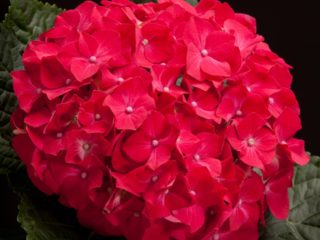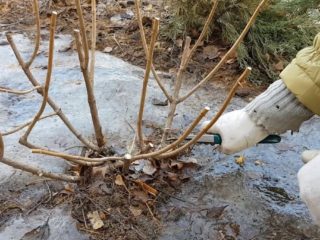Content
Hydrangea Mega Mindy is a spectacular, beautifully flowering shrub, bred in 2009 in Belgium. An unpretentious and winter-hardy plant can decorate gardens in most of the country. The culture is demanding on the composition of the soil and moisture in the summer.
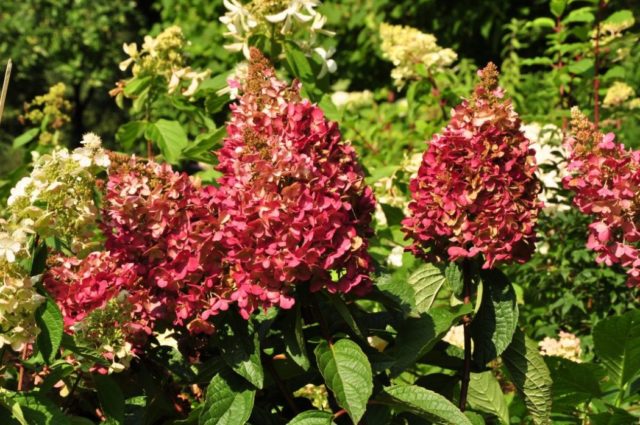
Mega Mindy inflorescences have an intense color
Description of hydrangea panicle variety Mega Mindi
A characteristic feature of panicle hydrangea Mega Mindy is huge inflorescences up to 24-30 cm long. A dense spreading crown is created by vertical shoots growing from a shallow, branched root system.
Stems rise up to 1.4-1.75 m. The diameter of a compact, erect bush is up to 1.4-1.6 m, sometimes more. Tough shoots with reddish bark are strong, under the weight of large panicles only slightly inclined, the bush does not fall apart. Paniculata hydrangea grows rapidly, in a year the shoots lengthen up to 20-25 cm.
Ovate large leaves 8-11 cm long are opposite. The dark green, slightly corrugated leaf blade is dense, rough, attached to the stem with a reddish petiole. In autumn, the leaves are yellowish.
Wide-pyramidal inflorescences bloom on the shoots of the current year. Conical panicles are dense, at first with a pointed apex, where still unblown flowers are concentrated, then the apex is rounded.
Hydrangea Mega Mindy has two types of flowers:
- sterile;
- fertile.
Infertile flowers on long pedicels with a diameter of 2.0-2.5 cm. Each one consists of 4 rounded, large petals. The flowers are arranged very densely, overlapping the fertile flowers - small, quickly falling off, from which fruits are created in the form of small, up to 3 mm, bolls. They ripen in the fall, cracking on top.
From the beginning of flowering, the petals are white, then turn pink and in August they turn cherry or crimson. The color depends on the composition of the soil and the weather. Flowering lasts a long time, from mid-July to late September or mid-October.
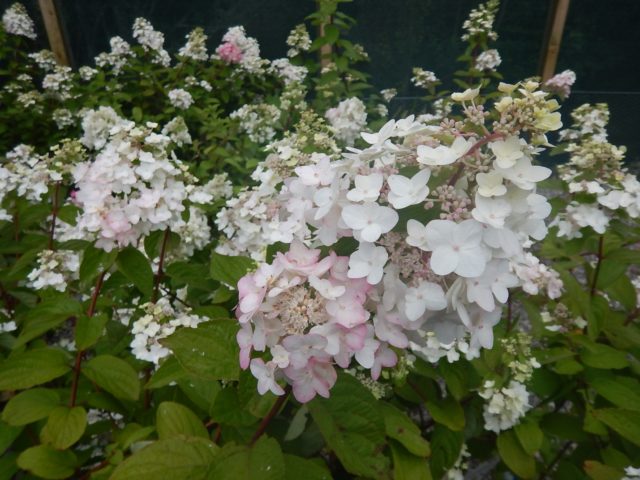
In July, the petals of the variety are just starting to turn slightly colored.
Hydrangea Mega Mindy in landscape design
The panicle hydrangea variety Hydrangeapaniculata Mega Mindy with a bright color of inflorescences is an effective element of various landscape compositions. Most often, the shrub grows as a colorful soloist. Hydrangea Mega Mindy looks beautiful in group plantings.
The culture loves a slightly acidic environment, hydrangeas are located next to plants that are equally demanding on the composition of the soil - coniferous and deciduous shrubs. The Mega Mindy variety shows all the brightness and harmony of compositional solutions in tree-shrub or shrub ensembles, mixborders with low conifers. Panicle hydrangea tolerates urban smoke and gas pollution well, is used for landscaping the territories of large enterprises and for decorating recreation areas.
Sometimes decorative hedges are created from the bushes. Hydrangea Mega Mindy is picturesque for the following reasons:
- flowering profuse, bright and long;
- colorful inflorescences do not lose their color and shape during the winter months, being in bouquets in residential buildings;
- sometimes in regions with low snow cover, ornamental shrubs are left without pruning, since the inflorescences remain colorful even in the cold season.
At the same time, it is taken into account that the next year the bushes will give very poor flowering without pruning.
Landscape designers recommend using the Mega Mindy variety in natural parks or English landscape style gardens.
Winter hardiness of hydrangea Mega Mindy
The plant tolerates frosts down to - 25 ° С, it is recommended for 4-8 winter hardiness zones. In a cozy, windless place, panicle hydrangea can withstand frosts - 30 ° C. The culture is planted to the latitude of St. Petersburg, and seeds are obtained in the southern regions. In open, hot areas in the southern regions, the growth of panicle hydrangea slows down, the inflorescences become small.
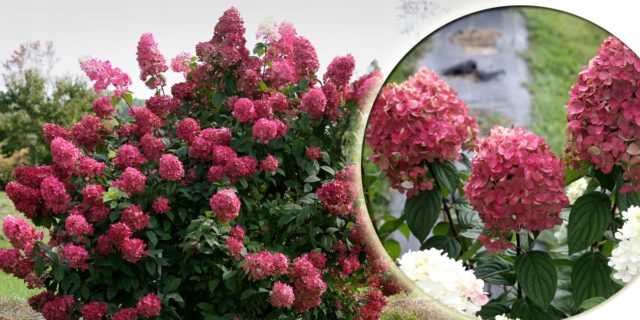
The solo hydrangea bush attracts special attention
Planting and caring for Mega Mindy hydrangea
A beautiful bloom depends on the correct planting site and substrate. It is equally important to follow the rules of agricultural technology.
Selection and preparation of the landing site
The plant is light-loving, it develops well in light partial shade. Prefers moderately moist soils to arid soils, and in sunny areas, regular watering is mandatory. The panicle species has high soil requirements:
- rich in humus;
- loamy, well structured, loose;
- wet;
- with acidity from 5.0 to 6.0 p
The color of the inflorescences of the Mega Mindy variety depends on the degree of acidity in the soil. The sour flowers are brighter. In the area with a neutral reaction, the substrate is oxidized in the planting pit. Calcareous soil negatively affects the growth of the shrub. Poor sandy areas are enriched with humus based on manure or compost. Hydrangea tolerates short-term stagnation of water.
Landing rules
The culture is planted in April, May, in the south - in September, October. During the summer period, the seedlings take root, grow stronger and become viable in the winter. The planting hole is dug 60 cm wide, 40-50 cm deep. The volume depends on the composition and acid reaction of the site. If the substrate is prepared different from the composition of the soil, a spacious hole is dug. When planting hydrangeas, the diameter of the hole exceeds the volume of the crown by 1.5 times. If the hydrangea is planted as an element of a hedge, the plants are placed in a trench 90-110 cm wide after 150 cm.
When laying a pit for the Mega Mindy variety, a drainage layer up to 10-15 cm is arranged below. The substrate is made up of equal parts of garden soil, peat, humus and a mixture for conifers.
Nutrients are also added:
- 20 g of urea;
- 30 g of potassium sulfate;
- 70 g superphosphate;
- 200 g bone meal.
The seedling is installed so that the root collar is 2-3 cm above the soil surface. Having covered the roots with the left substrate, the soil is compacted, watered with a bucket of water and mulched with a layer of 8-10 cm.Mulch is especially needed in the south, and if the planting hole is located in an open area ... The first month the seedling is shaded from direct sunlight.
Watering and feeding
The Mega Mindy variety is regularly watered every week, in the evening, 2 buckets under a bush. With sufficient precipitation, watering is carried out after 2 weeks, and in a rainy summer - 4 times per season. If autumn is dry, October watering is needed, up to 60 liters per plant.
For abundant flowering, the culture is fed 4-5 times:
- in spring and early summer with potassium sulfates, ammonium or organic matter;
- at the beginning of July and 15 days later, a solution of superphosphate and potassium sulfate is introduced;
- from late July to the first week of August - superphosphate and bone meal.
For hydrangeas, wood ash is not recommended, but products for heather or rhododendrons are used.
Pruning hydrangea Mega Mindy
Inflorescences form at the tops of young shoots, so the plants are pruned annually in early spring. In addition, with a strong thickening of the bush, the buds become smaller.Shoots are shortened by a third, leaving 4 buds. Old and damaged stems are removed in the fall after flowering.
Preparing for wintering hydrangea Mega Mindy
Although the paniculate species is winter-hardy, the bush must be prepared for wintering:
- fertilized in August;
- in September-October - water recharge irrigation;
- hilling with humus, loose soil;
- mulching with needles, peat.
Young bushes bend down or put a frame on top, cover with lutrasil, burlap.
Reproduction
Planting material Mega Mindy is obtained by cuttings or dividing the mother bush. Propagated also by grafting and sowing seeds. Cuttings are cut from one-year lateral shoots at the end of July. The bush is divided during transplantation, which is carried out every 6 years.
Diseases and pests
The leaves of panicle hydrangea are sometimes affected by chlorosis, becoming very light due to the lack of iron and magnesium in the alkaline soil. Eliminate the disease by foliar feeding with iron chelate.
Downy mildew causes the leaves to turn yellow. Plants are sprayed with a solution of 15 g of copper sulfate in 10 l of water with the addition of an adhesive.
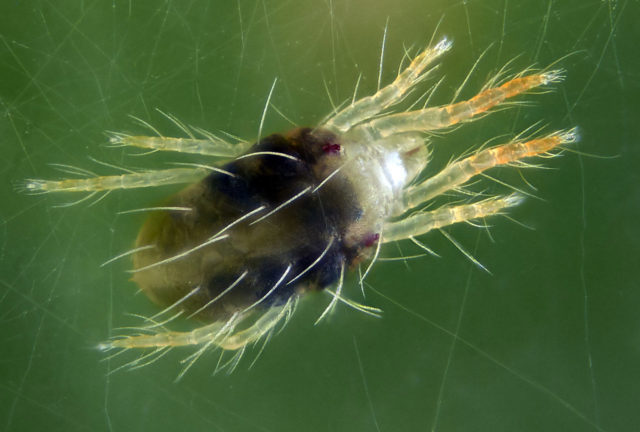
Of the pests of hydrangeas, leaf aphids and spider mites annoy them, which are destroyed with a solution of soap, special means
Conclusion
Hydrangea Mega Mindy is demanding on placement and soil conditions. The agrotechnical feature of the plant is periodic watering and feeding. Good care will give the spectacle of an enchanting colorful bloom.

